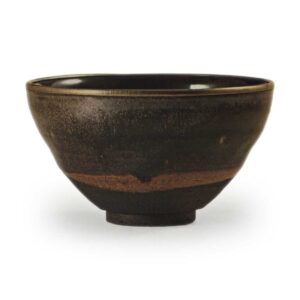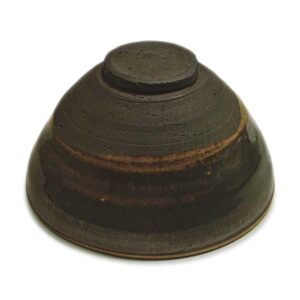

Height: 7.0 – 7.3cm
Diameter: 12.2cm
Foot diameter: 4.5cm
Height: 0.7cm
This haikatsuki tenmoku, which descended in the Kishu Tokugawa family, is said to have been in the possession of Tokugawa Ieyasu and entered the Kishu Tokugawa family as a Suruga family heirloom. However, this is not clear, and it may be the same as the “haikatsuki otenmoku” mentioned in the “Kanka Meibutsu Ki” as a shobu (treasured article) of the shogunate. Incidentally, the following eleven bowls are listed in the “Kanka Meibutsu Ki”.
Haikatsuki Gotenmoku (Shobu Shobu)
Haikatsuki Sakai Aburaya Jousuke (Owari-sama)
Haikatsuki Matsudaira Hizen-sama (Maeda-ke)
Haikatsuki Do
Haikatsuki Matsudaira Mutsu-dono (Date-ke)
Haikatsuki Do
Haikatsuki Mori Kai-dono
Haikatsuki Kobori Daizen-dono
Sakai Hakuemon
Sekiya (evening sun) Nanto Todaiji Shiseu
Niji (rainbow)
The above are the haikyotenmoku bowls known in 1660, when the “Ganka Meibutsu Ki” was published, but it is not clear when these bowls were transferred from the shogunate to the Kishu Tokugawa family. The “Ganka Meibutsu Ki” was compiled based on information from the Enshu period, namely the Genwa and Kan’ei eras, so it is not clear whether the tea bowl was in fact in the possession of the Tokugawa family at the time of publication.
Of the tea bowls in my collection, this one seems to have the most elegant shape and glaze, but the fact that this type of tea bowl came to be prized from the end of the Muromachi period, around the time of the astronomical phenomenon known as Tenmon, or the Shōō period, seems to symbolize the tastes of the transitional period when wabi-cha was gradually deepening, and is truly interesting. The black unglazed body, which has a high iron content, is similar to the Jian ware, but it is not the same type. There was probably another kiln in the Fujian area that produced this type of Tenmoku. In the “Chakimokuri Monogusa”, the haikyo is said to be from Seto, but it is difficult to tell that it is from Seto. The glaze that covers the lower part of the bowl is double-glazed, and yellow appears around the base. The black glaze on the upper part of the bowl has a silvery sheen and a purple hue in some places.
It is a famous bowl with a profound, wabi-like beauty that is truly worthy of Shōō’s taste.
The unique scraping marks from the foot to the waist are a characteristic of this type of tea bowl, and in particular, the scraping inside the foot is curved, unlike the straight lines of the Kenkan. The silver rim is a silver rim.
It is housed in a curved inner box with a tame-nuri finish, and the words “Hahikatsuki Tenmoku” are written in black ink on the lid of the paulownia wood box, but the author is unknown. The outer box is black lacquered and decorated with gold powder lettering. It is housed in a white habutae cloth bag, and a separate gold-lacquered bag is also included.
The “Taisho Meiki Kan” (Great Tea Bowl of the Taisho Period) lists nine bowls, but this bowl is not included. It was auctioned off by the Tokugawa family of Kishu in April 1927, but its subsequent history is unclear, and it has been in the possession of the current owner since the end of the Pacific War.



